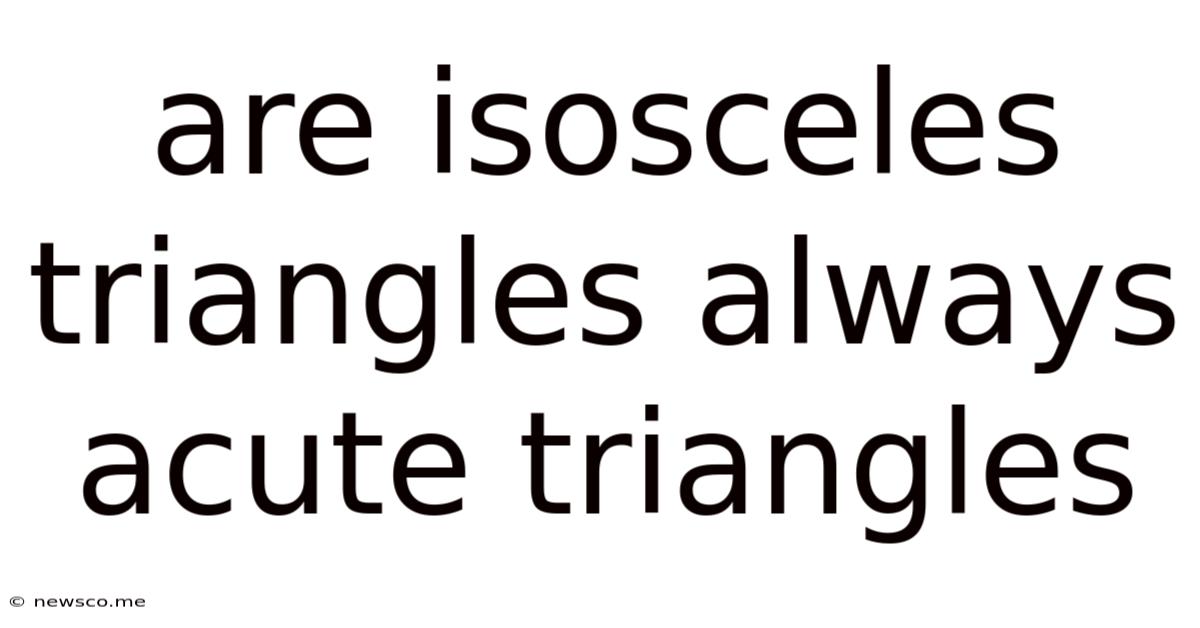Are Isosceles Triangles Always Acute Triangles
News Co
May 08, 2025 · 5 min read

Table of Contents
Are Isosceles Triangles Always Acute Triangles? Exploring the Relationship Between Triangle Types
The world of geometry is filled with fascinating relationships between different shapes and their properties. One such relationship that often sparks curiosity involves isosceles triangles and acute triangles. Many students initially assume that because an isosceles triangle has two equal sides, it must also be an acute triangle (meaning all angles are less than 90 degrees). However, this isn't necessarily true. Let's delve into the details, exploring the definitions, properties, and counter-examples to clarify the connection – or lack thereof – between isosceles and acute triangles.
Understanding Isosceles Triangles
An isosceles triangle is defined as a triangle with at least two sides of equal length. These equal sides are called legs, and the angle between them is called the vertex angle. The third side, which is potentially of a different length, is called the base. It's crucial to note the "at least two" part of the definition. An equilateral triangle, with all three sides equal, is a special case of an isosceles triangle.
Key Properties of Isosceles Triangles
- Two equal sides: This is the defining characteristic.
- Two equal angles: The angles opposite the equal sides are also equal. This is a crucial theorem in geometry.
- The sum of angles equals 180°: Like all triangles, the sum of the interior angles of an isosceles triangle is always 180 degrees.
Understanding Acute Triangles
An acute triangle is a triangle in which all three interior angles are acute angles – meaning each angle measures less than 90 degrees. This is a simple, yet important definition.
Can an Isosceles Triangle Be Obtuse or Right?
The critical point to understand is that the definition of an isosceles triangle doesn't restrict its angles in any way. While it's easy to visualize an isosceles triangle that is also acute, it's equally possible to construct isosceles triangles that are obtuse (containing one angle greater than 90 degrees) or even right (containing one angle equal to 90 degrees).
Isosceles Right Triangles
Consider a right-angled triangle with two legs of equal length. This is an isosceles right triangle, often referred to as a 45-45-90 triangle because its angles measure 45°, 45°, and 90°. This demonstrates that an isosceles triangle can absolutely be a right triangle.
Isosceles Obtuse Triangles
To visualize an isosceles obtuse triangle, imagine a triangle with two equal sides that are relatively short compared to the base. The angle opposite the long base will be the obtuse angle, exceeding 90 degrees. The other two angles will be acute and equal to each other, but their sum will be less than 90 degrees to maintain the total angle sum of 180 degrees. The precise angles will depend on the lengths of the sides, as we can easily calculate using the Law of Cosines and the Law of Sines.
Visualizing Different Types of Isosceles Triangles
It's helpful to visualize these different types of isosceles triangles:
-
Isosceles Acute Triangle: Draw an equilateral triangle (a special case of an isosceles triangle). All angles are 60°, making it acute. Now, slightly adjust the lengths of the sides while maintaining two sides equal; it will remain an acute isosceles triangle, as long as the vertex angle remains less than 90 degrees.
-
Isosceles Right Triangle: Imagine a square and draw a diagonal. This diagonal divides the square into two congruent isosceles right triangles, each with angles of 45°, 45°, and 90°.
-
Isosceles Obtuse Triangle: Start with a long base. Construct two equal sides that meet at a point above the base, forming an obtuse angle at the vertex. This shows that the vertex angle can be greater than 90 degrees.
Mathematical Proof and Calculations
Let's use mathematical principles to confirm the possibility of obtuse and right isosceles triangles.
1. Isosceles Right Triangle:
In a right isosceles triangle, let the two equal sides be denoted as 'a'. By the Pythagorean theorem (a² + a² = c²), the hypotenuse (c) will be √2 * a. The angles will always be 45°, 45°, and 90°.
2. Isosceles Obtuse Triangle:
To illustrate an obtuse isosceles triangle, let's use the Law of Cosines. Let the two equal sides be 'a', and the base be 'b'. Let the obtuse angle (opposite the base 'b') be θ. The Law of Cosines states:
b² = a² + a² - 2a²cos(θ)
If θ > 90°, then cos(θ) will be negative. This equation can be satisfied with various values of 'a' and 'b', demonstrating the existence of obtuse isosceles triangles. For instance, if a = 1 and b = 1.5, the solution exists.
Common Misconceptions
The primary misconception stems from a lack of thorough understanding of the definitions of isosceles and acute triangles. Simply because a triangle has two equal sides doesn't automatically imply that all its angles must be less than 90 degrees. The angle measurements are independent of the side length equality, except that the angles opposite the equal sides are always equal.
Conclusion
In conclusion, while many commonly encountered isosceles triangles are acute, it's incorrect to assume that all isosceles triangles are acute. Isosceles triangles can also be right-angled or obtuse-angled. Understanding this distinction is vital for a complete grasp of geometric principles and for avoiding common errors in geometrical problem-solving. This understanding also highlights the importance of clearly defining and distinguishing between different geometrical properties and utilizing appropriate mathematical tools to solve complex geometrical problems. Always refer back to fundamental definitions and theorems to avoid making incorrect assumptions.
Latest Posts
Related Post
Thank you for visiting our website which covers about Are Isosceles Triangles Always Acute Triangles . We hope the information provided has been useful to you. Feel free to contact us if you have any questions or need further assistance. See you next time and don't miss to bookmark.